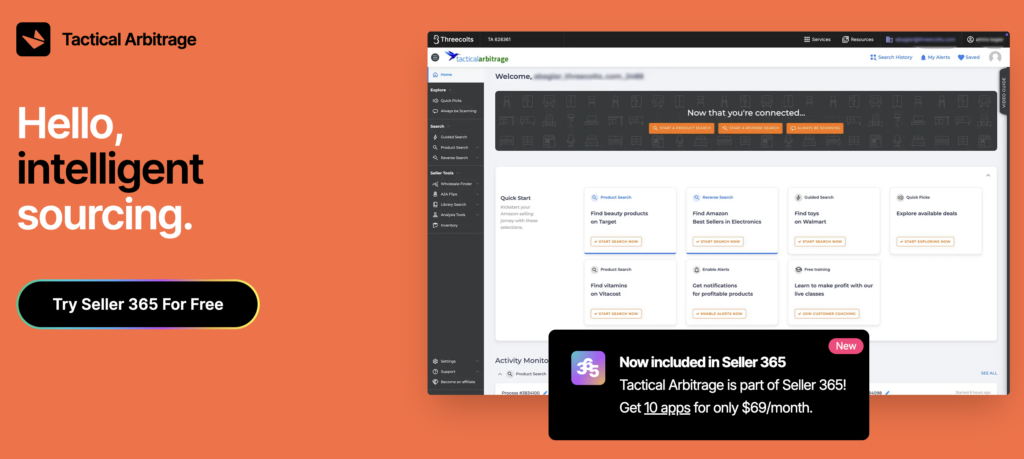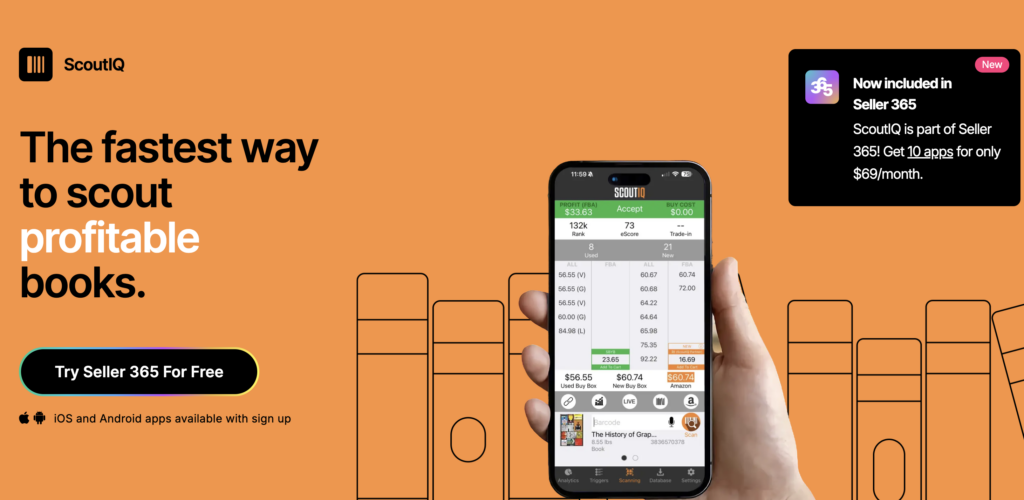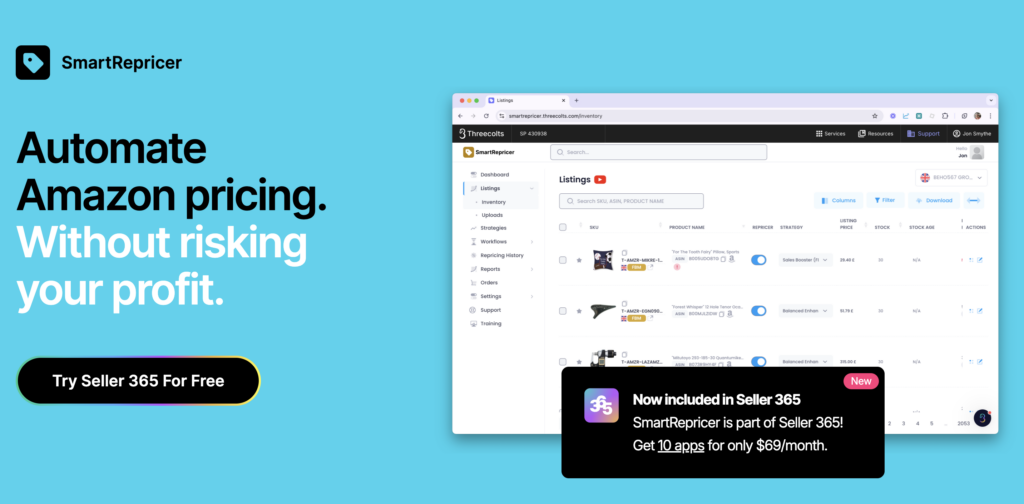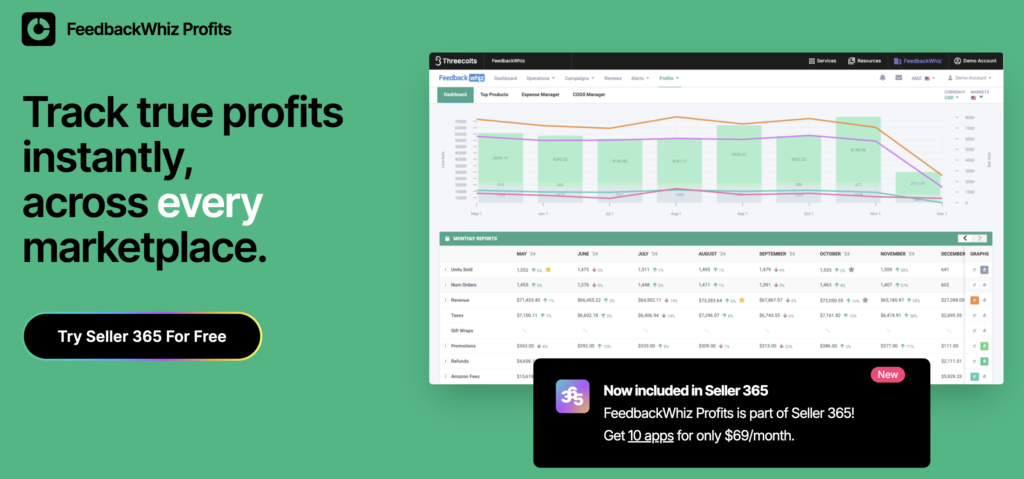- Blog
-
For Sellers
How to sell on Amazon international marketplaces
A step‑by‑step guide to expanding your Amazon business internationally—choosing markets, setting up accounts, and managing global operations.

Selling on Amazon.com is just the beginning. With over 300 million active customer accounts across 21 international marketplaces, Amazon’s global network offers sellers unprecedented access to customers worldwide. These marketplaces span four major regions and represent some of the largest ecommerce opportunities on the planet.
International expansion can transform your Amazon business. While domestic sales fluctuate with seasonal trends, global selling lets you tap into different peak seasons, cultural events, and economic cycles across multiple countries. When it’s slow season in the US, it might be peak shopping time in Australia or Germany.
Fortunately, Amazon provides the infrastructure to sell globally without building separate operations in each country. Here’s a rundown.
Understanding Amazon’s global marketplace network
Amazon operates 21 distinct marketplaces across four major regions. Each marketplace serves customers in specific countries with localized shopping experiences, payment methods, and fulfillment networks. The scope is massive: from Amazon.com serving US customers to Amazon.co.jp reaching Japanese shoppers, each store operates with its own inventory, pricing, and seller requirements.
Americas region:
- Amazon.com (United States)
- Amazon.ca (Canada)
- Amazon.com.mx (Mexico)
- Amazon.com.br (Brazil)
Europe region:
- Amazon.co.uk (United Kingdom)
- Amazon.de (Germany)
- Amazon.fr (France)
- Amazon.it (Italy)
- Amazon.es (Spain)
- Amazon.pl (Poland)
- Amazon.nl (Netherlands)
- Amazon.se (Sweden)
- Amazon.com.be (Belgium)
- Amazon.com.tr (Turkey)
Asia-Pacific region:
- Amazon.co.jp (Japan)
- Amazon.in (India)
- Amazon.com.au (Australia)
- Amazon.sg (Singapore)
Middle East and North Africa region:
- Amazon.ae (United Arab Emirates)
- Amazon.sa (Saudi Arabia)
- Amazon.eg (Egypt)
The regional structure affects how you set up seller accounts. Amazon offers unified accounts for some regions (like North America and Europe) where one account can manage multiple marketplaces. Other regions require separate, country-specific accounts. This structure determines your registration process, fee structure, and account management workflow.
All Amazon marketplaces share core features that make them instantly recognizable to customers worldwide. The trusted Amazon buying experience, customer reviews, Prime shipping options, and seller performance metrics work consistently across markets. However, each marketplace adapts to local preferences with language options, payment methods, customer service in local languages, and region-specific product categories.
When to start selling internationally
Successful international expansion requires hitting specific benchmarks before taking the leap. Amazon recommends that sellers have a Professional selling plan, consistent sales performance on their home marketplace, and the operational capacity to handle international requirements. This typically means established sellers rather than those just starting out.
Your products need international appeal and compliance capability. Some products that work domestically face restrictions internationally due to safety standards, electrical compatibility, or regulatory requirements. For example, electronics designed for 110V US outlets won’t work in European markets without adapters or modifications. Similarly, products with English-only packaging might struggle in non-English-speaking markets.
Language considerations play a crucial role in timing. You’ll need customer service capabilities in local languages unless you use Fulfillment by Amazon (FBA), which provides customer service on your behalf. This language barrier often determines whether sellers are ready for specific markets or should focus on English-speaking countries first.
Resource requirements checklist:
- Established sales performance on your home marketplace
- Products suitable for international markets
- Capital for inventory, shipping, and compliance costs
- Understanding of tax and regulatory requirements
- Customer service capabilities or FBA enrollment
- Time to manage multiple marketplace operations
The seasonal timing can also affect your success. Q4 shopping seasons vary by region, with different cultural holidays and shopping patterns. Understanding these cycles helps you launch at optimal times rather than missing peak seasons entirely.
How to choose your target marketplaces
Amazon provides sophisticated tools to guide your marketplace selection decisions. The Marketplace Product Guidance tool analyzes global demand for your existing products and provides category insights and product recommendations. This data-driven approach beats guessing about which markets might work for your products.
The Sell Globally dashboard offers even deeper insights for sellers already active internationally. It shows sales potential by country and product while highlighting current trends worldwide. These tools help you prioritize markets based on actual customer demand rather than assumptions about market size or geographic proximity.
Language requirements vary significantly across marketplaces. English works in the US, UK, Australia, and Singapore. However, succeeding in Germany requires German listings, while Japan demands Japanese content. Some sellers start with English-speaking markets to minimize language barriers before expanding into markets requiring translation.
Market prioritization factors:
- Existing customer demand for your products
- Language requirements and your capabilities
- Regulatory complexity and compliance costs
- Competition levels in your product categories
- Seasonal shopping patterns and peak periods
- Fulfillment and shipping considerations
Cultural considerations affect product appeal and marketing approaches. Products popular in the US might not resonate with European or Asian customers due to different preferences, sizing standards, or usage patterns. Understanding these differences helps avoid costly inventory investments in inappropriate markets.
Step-by-step account setup process
Amazon’s Global Selling follows a systematic six-step process regardless of your target markets. This framework applies whether you’re expanding from the US to international markets or entering the US from another country.
The complete process:
- Create regional or country-specific selling accounts
- Select products appropriate for each target market
- Complete tax, regulatory, and compliance requirements
- Create product listings in local languages
- Choose fulfillment methods and ship inventory
- Manage ongoing operations with Amazon tools
The process starts with understanding which accounts you need. If you’re US-based and want to sell in Canada or Mexico, you can use your existing North America and Brazil unified account. However, expanding to Europe requires creating a separate European account that covers multiple European marketplaces. Asia-Pacific and Middle East markets require individual country-specific accounts.
Account linking becomes important as you expand across regions. Amazon allows you to link accounts from different regions, which simplifies management and may reduce your total monthly fees. The linking process happens through the Sell Globally Dashboard and helps you track performance across all your international operations.
Registration requirements by region
Each region has distinct registration requirements that reflect local business practices and regulatory frameworks. Understanding these requirements upfront prevents delays and ensures smooth account approval processes.
North America (US, Canada, Mexico, Brazil)
North American registration uses a unified account structure that covers all four countries. You’ll need a valid credit card, bank account, phone number, and tax information. The system determines whether you need a W-9 form (US taxpayer) or a W-8BEN form (non-US taxpayer) through an automated interview process.
Additional documentation might include scanned copies of your passport, national ID, bank account statement, or credit card statement. Your bank account must be located in a country supported by Amazon’s Currency Converter, and all information must stay current throughout your selling relationship.
Europe (Multiple countries under one account)
European registration requires a valid credit card, phone number, and tax information. The crucial requirement is a VAT (Value Added Tax) number. While you can complete initial registration without one, Amazon requires a VAT number before you can actually sell in European markets.
The European account structure is particularly seller-friendly. When you register for any Amazon European marketplace, your account automatically enables selling across all European marketplaces. This means registering in Germany gives you immediate access to the UK, France, Italy, Spain, the Netherlands, Poland, Sweden, Belgium, and Turkey markets.
Banking requirements are flexible but specific. Amazon accepts UK and US bank accounts, plus accounts from all Eurozone countries. Account verification takes up to four business days, during which you can list products but can’t receive disbursements.
Asia-Pacific (Country-specific accounts)
Asia-Pacific markets require individual country-specific accounts for Japan, Australia, India, and Singapore. Each country has distinct requirements reflecting local business practices.
Japan requires the most extensive documentation, including photo identification (passport, driver’s license, or resident registration card) and recent bills or statements issued within 180 days. The verification documents must be current and match your registration information exactly.
Australia uses Hyperwallet as a third-party payment provider, requiring Australian bank account information. India registration is currently by invitation only for international sellers. Singapore follows similar patterns to other English-speaking markets with standard documentation requirements.
Middle East and North Africa (Country-specific accounts)
Middle East markets (UAE, Saudi Arabia, Egypt, Turkey) require country-specific accounts with standard documentation. These markets are expanding rapidly, but require an understanding of local business practices and cultural preferences.
Turkey presents unique challenges with its separate account requirements and limited Build International Listings tool support. UAE and Saudi Arabia offer more integrated experiences with other Amazon tools.
Understanding costs and fees
Amazon’s international fee structure balances simplicity with regional variations. Professional selling plan fees vary by region, but Amazon’s account linking feature can reduce your total costs significantly.
Professional selling plan fees
Individual regions charge separate Professional selling plan fees: Americas ($39.99/month), Europe (€39/month), and country-specific fees for Asia-Pacific and Middle East markets. However, Amazon’s linking system charges you either $39.99 USD equivalent or the sum of individual region fees, whichever is lower.
This linking benefit becomes substantial as you expand. Instead of paying separate fees for each region, you might pay just the equivalent of one Professional plan fee across all your linked accounts.
Referral fees and variations
Referral fees vary by product category and marketplace but follow similar structures globally. You’ll pay a percentage of the total price or a minimum amount (whichever is greater) for each item sold. However, the specific percentages can vary between marketplaces.
European markets might have different referral fee structures than North American markets for the same product categories. These differences reflect local competitive conditions and operational costs in each region.
Currency conversion and payments
Amazon’s Currency Converter simplifies international payments by depositing proceeds from multiple countries into your primary bank account. This eliminates the need for local bank accounts in each country where you sell.
Alternatively, you can establish local bank accounts in each region for direct deposits. This approach might offer better exchange rates but requires maintaining banking relationships in multiple countries and potentially establishing legal business entities abroad.
Product listing requirements
International product listings require more than simple translation. Each marketplace has specific requirements for language, format, and compliance that affect your product visibility and sales success.
Language and translation needs
Product listings must appear in local marketplace languages. Amazon’s Build International Listings tool can automatically translate listings in many cases, but human review ensures accuracy and cultural appropriateness.
Amazon offers translation services through its Service Provider Network when automatic translation isn’t sufficient. Professional translation becomes particularly important for complex products requiring detailed explanations or safety information.
For products matching existing listings, you often don’t need to provide translated content. Amazon pairs your offer with existing product detail pages that already appear in the local language.
Compliance and regulatory differences
Product standards vary significantly between countries, creating compliance requirements that go beyond language translation. Electronics must meet different voltage and safety standards. Consumer products face varying regulatory requirements. Even packaging and labeling requirements differ between markets.
Amazon provides compliance tools, including Manage Your Compliance and Compliance Reference, to help navigate these requirements. The Service Provider Network also includes compliance experts who understand specific country requirements.
Common compliance areas:
- Electrical safety standards and voltage requirements
- Chemical and hazardous material restrictions
- Food and supplement regulations
- Medical device classifications
- Toy safety standards
- Environmental and recycling requirements
Build International Listings tool
The Build International Listings tool streamlines the process of creating listings across multiple marketplaces. It automatically creates listings in target marketplaces based on your source marketplace products, updates pricing based on currency fluctuations, and maintains synchronized inventory across connected markets.
The tool works within regions (like managing multiple European marketplaces from one source) and across regions when you’ve linked accounts. It handles pricing rules, currency conversion, and automatic updates when you modify source listings.
Fulfillment options explained
International fulfillment involves choosing between Amazon’s Fulfillment by Amazon (FBA) services and handling fulfillment yourself (Fulfilled by Merchant). Each approach offers distinct advantages depending on your business model and target markets.
FBA vs. self-fulfillment internationally
FBA provides comprehensive solutions, including storage, picking, packing, shipping, returns processing, and customer service in local languages. This full-service approach eliminates most operational complexities of international selling but requires shipping inventory to Amazon fulfillment centers in each target country.
Self-fulfillment gives you complete control over inventory and shipping but requires managing international shipping, customs documentation, customer service in local languages, and returns processing. The operational burden increases significantly with each additional marketplace.
Cost considerations vary by product type and sales volume. FBA fees include storage, fulfillment, and customer service costs but eliminate international shipping expenses for individual orders. Self-fulfillment avoids FBA fees but includes international shipping costs that can be substantial for individual orders.
Regional fulfillment programs
Europe offers sophisticated fulfillment programs that leverage Amazon’s integrated European network. These programs can dramatically reduce complexity while improving delivery times for European customers.
Pan-European FBA distributes your inventory across European fulfillment centers automatically. You ship inventory to one European country, and Amazon redistributes products across the network to optimize delivery times and costs. This program eliminates per-unit cross-border fulfillment fees within Europe.
European Fulfillment Network (EFN) serves as a simpler starting point for European expansion. You ship inventory to fulfillment centers in your preferred European country, then Amazon fulfills orders across all European marketplaces from that single inventory pool. Additional fees apply for cross-border shipments within Europe.
Multi-Country Inventory (MCI) optimizes delivery times by placing popular products directly in countries with high demand. This program works best for established sellers with sales data indicating which products sell well in specific European countries.
Shipping and customs considerations
International fulfillment involves complex customs and regulatory requirements. When shipping inventory to Amazon fulfillment centers internationally, you act as both exporter of record (in the source country) and importer of record (in the destination country).
Amazon will not serve as the importer of record for any FBA inventory shipments. This responsibility requires understanding customs documentation, paying applicable duties and taxes, and ensuring compliance with import/export regulations in both countries.
Key shipping requirements:
- Commercial invoices with accurate product descriptions
- Customs harmonized codes for proper classification
- Delivered Duty Paid (DDP) shipping terms
- Proper packaging and labeling for international transport
- Documentation showing you (not Amazon) as the importer of record
Many sellers work with customs brokers or freight forwarders to handle these complexities. These service providers understand international shipping requirements and can manage the documentation and compliance aspects of international inventory movement.
Managing international operations
Operating across multiple Amazon marketplaces creates unique challenges that domestic sellers never face. Tax obligations multiply with each new country. Customer service must happen in local languages and time zones. Currency fluctuations affect pricing strategies. Returns management becomes complex when customers and inventory are in different countries.
Tax and VAT requirements
Each country has distinct tax requirements that affect your selling obligations. European markets require VAT registration and collection, with rates varying by country and product type. Asia-Pacific markets have different consumption tax structures. Understanding these requirements prevents compliance issues that could affect your account health.
Amazon provides tax calculation services in some markets, but sellers remain responsible for understanding their obligations and ensuring compliance. The Service Provider Network includes tax professionals who specialize in international Amazon selling requirements.
Customer service in local languages
Marketplace selling requires customer service in local languages unless you use FBA. Amazon handles customer service for FBA orders in local languages, which eliminates this challenge for FBA sellers. Self-fulfilling sellers must provide customer service capabilities in each marketplace language or use service providers who offer multilingual support.
Response time requirements remain consistent globally – you must respond to customer inquiries within 24 hours. However, time zone differences can make this challenging when your business operates in one region while serving customers globally.
Returns handling across borders
International returns require careful planning and clear policies. Amazon’s policies vary by marketplace, but generally, customers shouldn’t face additional charges after purchase completion. This means you’re responsible for return shipping costs and any customs or duty charges.
For international sellers, Amazon offers different return options, including returnless refunds for low-value items, prepaid return labels for international shipping, or working with returns service providers who can handle local returns processing.
Managing international operations with the right tools
Selling across multiple Amazon marketplaces creates operational complexity that grows exponentially with each new market. You’re suddenly managing different currencies, languages, tax requirements, customer service expectations, and marketplace rules. What works as manageable tasks for one marketplace becomes overwhelming when multiplied across five, ten, or twenty international markets.
The challenge isn’t just volume—it’s the fragmentation. Most Amazon seller tools focus on a single marketplace, forcing you to juggle multiple software subscriptions, login credentials, and data sources. You might use one tool for US repricing, another for European feedback management, and a third for inventory planning across Asia-Pacific markets. This fragmented approach creates gaps in your operations and multiplies your software costs.
Seller 365 solves this multi-marketplace complexity by providing comprehensive international coverage across its entire toolkit. Instead of managing separate tools for each region, you get unified operations across all your global Amazon marketplaces through a single platform.

Tactical Arbitrage covers 12 major Amazon marketplaces: USA, Canada, Mexico, Brazil, Germany, UK, France, Italy, Spain, Australia, Japan, and India. This global coverage means you can research profitable products across multiple regions from one interface, identifying arbitrage opportunities that other sellers miss by focusing on single markets.
The international capability becomes particularly powerful for understanding regional price differences and demand patterns. A product might be oversaturated in the US market but have strong demand and higher margins in European or Asia-Pacific markets.

ScoutIQ supports the USA and UK marketplaces, covering the two largest English-language book markets on Amazon. This coverage is strategic. English-language books often have demand across both markets, allowing you to optimize your sourcing and inventory decisions based on opportunities in both regions.

SmartRepricer supports 22 Amazon marketplaces, with more international coverage than any other major repricing tool. This includes the USA, Canada, Mexico, Brazil, Germany, UK, France, Italy, Spain, Poland, Netherlands, Sweden, Belgium, UAE, Saudi Arabia, Egypt, Australia, Japan, Singapore, Turkey, India, and South Africa.
This extensive coverage becomes crucial as you expand internationally because repricing strategies must account for local competition, currency fluctuations, and regional shopping patterns. Managing repricing across 20+ marketplaces with separate tools would be operationally impossible for most sellers.
FeedbackWhiz Emails, Alerts, and Profits
All three FeedbackWhiz tools (Emails, Alerts, and Profits) support 21 Amazon marketplaces each: USA, Canada, Mexico, Brazil, Germany, UK, France, Italy, Spain, Poland, Netherlands, Sweden, Belgium, UAE, Saudi Arabia, Egypt, Australia, Japan, Singapore, Turkey, and India.

FeedbackWhiz Emails handles review and feedback automation across all these markets with local language capabilities and marketplace-specific compliance features.

FeedbackWhiz Alerts monitors your listings, reviews, and account health across all 21 marketplaces from a unified dashboard.

FeedbackWhiz Profits provides comprehensive financial reporting that consolidates performance data across all your international operations.
The Seller 365 advantage
The traditional approach to international Amazon selling requires assembling tools from different vendors, each with limited international coverage. You might pay $50/month for US repricing, $30/month for European feedback management, $40/month for profit tracking across three Asian markets, and additional fees for other essential functions.
Seller 365 provides all these capabilities across the maximum number of international marketplaces for $69/month total. You get Tactical Arbitrage, ScoutIQ, SmartRepricer, and all three FeedbackWhiz tools, plus InventoryLab for prep and shipping management. 10 essential seller apps with comprehensive international coverage for less than you’d pay for two or three specialized tools with limited geographic reach.
Making your operations a lot simpler is even more valuable than the cost savings. Instead of logging into multiple platforms, managing separate data sources, and trying to coordinate operations across fragmented tools, you manage your entire global Amazon operation from a unified platform. This consolidation reduces errors, saves time, and provides the comprehensive oversight needed for successful international operations.
Getting started with your expansion
International expansion succeeds through systematic planning rather than opportunistic market entry. Your expansion roadmap should prioritize markets based on data-driven insights, account for operational complexity, and sequence launches to build capabilities progressively.
Start your international Amazon journey with a clear understanding of the requirements, costs, and operational changes involved. With proper planning and the right tools, Amazon’s global marketplace network offers unprecedented opportunities to grow your business beyond any single country’s borders.
Ready to expand internationally with the right tools? Try Seller 365 free for up to 14 days and experience comprehensive international marketplace management across all your global Amazon operations.






















